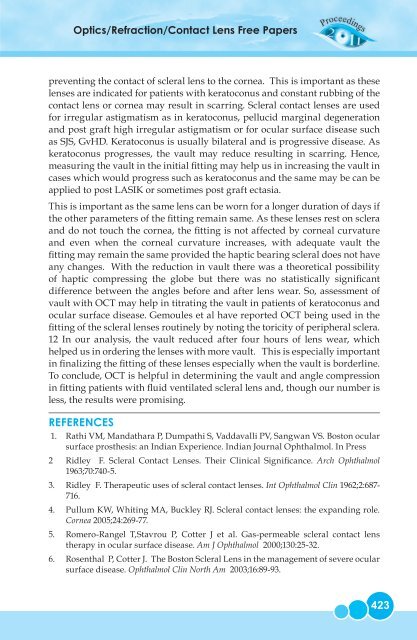Optics/Refraction/ Contact Lens Free Papers - aioseducation
Optics/Refraction/ Contact Lens Free Papers - aioseducation
Optics/Refraction/ Contact Lens Free Papers - aioseducation
You also want an ePaper? Increase the reach of your titles
YUMPU automatically turns print PDFs into web optimized ePapers that Google loves.
<strong>Optics</strong>/<strong>Refraction</strong>/<strong>Contact</strong> <strong>Lens</strong> <strong>Free</strong> <strong>Papers</strong><br />
preventing the contact of scleral lens to the cornea. This is important as these<br />
lenses are indicated for patients with keratoconus and constant rubbing of the<br />
contact lens or cornea may result in scarring. Scleral contact lenses are used<br />
for irregular astigmatism as in keratoconus, pellucid marginal degeneration<br />
and post graft high irregular astigmatism or for ocular surface disease such<br />
as SJS, GvHD. Keratoconus is usually bilateral and is progressive disease. As<br />
keratoconus progresses, the vault may reduce resulting in scarring. Hence,<br />
measuring the vault in the initial fitting may help us in increasing the vault in<br />
cases which would progress such as keratoconus and the same may be can be<br />
applied to post LASIK or sometimes post graft ectasia.<br />
This is important as the same lens can be worn for a longer duration of days if<br />
the other parameters of the fitting remain same. As these lenses rest on sclera<br />
and do not touch the cornea, the fitting is not affected by corneal curvature<br />
and even when the corneal curvature increases, with adequate vault the<br />
fitting may remain the same provided the haptic bearing scleral does not have<br />
any changes. With the reduction in vault there was a theoretical possibility<br />
of haptic compressing the globe but there was no statistically significant<br />
difference between the angles before and after lens wear. So, assessment of<br />
vault with OCT may help in titrating the vault in patients of keratoconus and<br />
ocular surface disease. Gemoules et al have reported OCT being used in the<br />
fitting of the scleral lenses routinely by noting the toricity of peripheral sclera.<br />
12 In our analysis, the vault reduced after four hours of lens wear, which<br />
helped us in ordering the lenses with more vault. This is especially important<br />
in finalizing the fitting of these lenses especially when the vault is borderline.<br />
To conclude, OCT is helpful in determining the vault and angle compression<br />
in fitting patients with fluid ventilated scleral lens and, though our number is<br />
less, the results were promising.<br />
REFERENCES<br />
1. Rathi VM, Mandathara P, Dumpathi S, Vaddavalli PV, Sangwan VS. Boston ocular<br />
surface prosthesis: an Indian Experience. Indian Journal Ophthalmol. In Press<br />
2 Ridley F. Scleral <strong>Contact</strong> <strong>Lens</strong>es. Their Clinical Significance. Arch Ophthalmol<br />
1963;70:740-5.<br />
3. Ridley F. Therapeutic uses of scleral contact lenses. Int Ophthalmol Clin 1962;2:687-<br />
716.<br />
4. Pullum KW, Whiting MA, Buckley RJ. Scleral contact lenses: the expanding role.<br />
Cornea 2005;24:269-77.<br />
5. Romero-Rangel T,Stavrou P, Cotter J et al. Gas-permeable scleral contact lens<br />
therapy in ocular surface disease. Am J Ophthalmol 2000;130:25-32.<br />
6. Rosenthal P, Cotter J. The Boston Scleral <strong>Lens</strong> in the management of severe ocular<br />
surface disease. Ophthalmol Clin North Am 2003;16:89-93.<br />
423

















